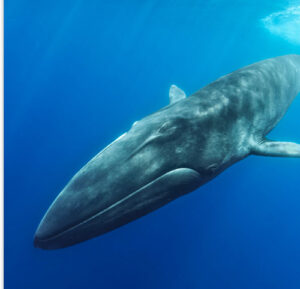The Fin Whale

By Terri Estes
The fin whale is the second largest animal on earth (the blue whale is the largest). At 75 feet long and weighing up to 100,000 pounds, these giants can live up to 90 years. Fin whales can be recognized by their rather pointed, triangular shaped head, their prominent back and pronounced dorsal fin – hence the name!
 New research released by marine biologists from the Wildlife Conservation Society, a global conservation group that also happens to operate the New York Aquarium, showed an amazing discovery! Over the last four years, they detected the unique fin whale song in every month of the year off of the coast of Long Island. Before this study, fin whales were thought to be off the coast of the New York/New Jersey shores mostly between the months of September and December. All whales make all sorts of sounds to communicate with each other, but only males sing. Each whale species has its own distinctive song sound, and the fin whale is no exception. They have a deep baritone voice that can carry up to 600 miles away. The study placed multiple acoustic buoys about 20 miles offshore of Long Island. The scientists then analyzed the data and found that the animals are constantly being detected off the coast between Montauk, NY and Cape May, NJ.
New research released by marine biologists from the Wildlife Conservation Society, a global conservation group that also happens to operate the New York Aquarium, showed an amazing discovery! Over the last four years, they detected the unique fin whale song in every month of the year off of the coast of Long Island. Before this study, fin whales were thought to be off the coast of the New York/New Jersey shores mostly between the months of September and December. All whales make all sorts of sounds to communicate with each other, but only males sing. Each whale species has its own distinctive song sound, and the fin whale is no exception. They have a deep baritone voice that can carry up to 600 miles away. The study placed multiple acoustic buoys about 20 miles offshore of Long Island. The scientists then analyzed the data and found that the animals are constantly being detected off the coast between Montauk, NY and Cape May, NJ.
The whaling industry decimated the population of the fin whale over the last several decades. However, through strong conservation efforts, the fin whales are making a slow comeback. It is hard to know their current population because they are highly migratory and very elusive, mostly because they usually prefer deep waters. Ship strikes are currently the most pressing issue effecting the fin whale population. Fins spend most of the nighttime near the surface. This makes them highly susceptible to a collision with a ship. As a matter of fact, fin whales are the most common whale to be struck by a ship, even though they are not nearly the most common whale species.
In December 2012, just after Hurricane Sandy, a 60-foot fin whale washed up alive on the bayside of Breezy Point. Despite efforts to save it, the whale ultimately died. A necropsy showed that the whale was severely emaciated and had lesions in its stomach and kidneys.
The recent research shows fin whales are doing well in our waters. We might not easily see fin whales feeding off the shoreline in Rockaway like we see the humpback, sperm whales and minke whales, but it is nice to know that these massive creatures are out there, thriving off our coastline! Let’s all continue to do our part to keep our beaches and oceans clean. Not only for our wildlife, but for us as well.


